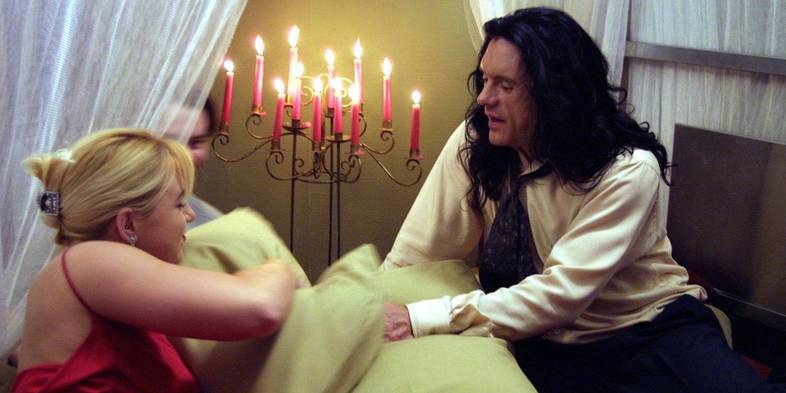The Disaster Artist: 5 Strangest Things From The Book That Didn’t End Up In The Movie

The book, co-written with Tom Bissell, chronicled Sestero’s experience getting to know the enigmatic Tommy Wiseau, a mysterious man of unknown age and origin who had unlikely dreams of fame and stardom. The book moves back and forth between telling the story of the author’s early relationship with Wiseau, and chronicling the experience on the chaotic production of Wiseau’s movie, The Room, which before long became an ironic hit that spawned regular midnight screenings that continue to this day.
Now we have the movie-behind-the-movie, with the release of the film The Disaster Artist, starring James Franco as Wiseau and his brother Dave Franco as Sestero, with James Franco directing. The film opened Friday in select cities, with a wide release on Dec. 8, and reviews have been enthusiastic, with a Tomatometer score in the 90s.
The film is remarkably faithful to the book, with most of the outlandish Tommy behavior drawn straight from the page, and by extension real life. Some things were made up for the movie, though. The Bryan Cranston cameo, for instance, didn’t actually happen – although its location, Canter’s Deli, does pop up in the book – nor did Sestero ever try out for Malcolm in the Middle. And the scene from the film’s trailer – in which Wiseau repeatedly forgets the line in the “I did not hit her” scene – happens a bit differently in the book. And overall, the tone of the movie is lighter than that of the book, which goes to some pretty dark places.

The strangest and most prominent omissions in the book-to-movie translation:
Most notably, the movie somewhat soft-pedals just how tyrannical, bordering on abusive, Tommy Wiseau was, both on set and in his everyday dealings with Sestero. Sure, we see glimpses in the film of Franco-as-Wiseau’s creepy and bullying behavior, especially when he berates the actress playing Lisa (Ari Graynor) during the filming of the sex scenes. This manifests itself in The Room itself, a film whose gender politics are so backward that writer David Futrelle once called it an unintentional men’s rights activist manifesto.
The tenth chapter of the book, in particular, deals with Wiseau’s manipulative, borderline abusive treatment of Sestero at a time years before the film, with Wiseau engaging in such actions as guilt-tripping Sestero for any career success, stealing his acting reel, signing Sestero up for the Bay-to-Breakers running race without permission, and reacting with horror to Sestero having any friends besides him. Later, he terrifies Sestero by taking him on a speeding car ride. “There was something twisted and poisonous inside him,” Sestero writes.
The book also has much more detail about Greg Sestero’s background and early career than is seen in the film. As a child, he wrote a letter to director John Hughes, who wrote back, and he had quite a few more screen credits, pre-The Room, than revealed by the film, which implies that Sestero had barely acted before the film’s events. He also worked in high-end retail for a lengthy period, but that’s not in the movie.
The 1999 drama film The Talented Mr. Ripley plays a key role in The Disaster Artist book. A friend in San Francisco who dislikes Wiseau takes Sestero to see it, in an attempt show Sestero that Wiseau is a con artist (like Matt Damon’s Ripley in the film), and as a way to warn Sestero against Wiseau’s influence. Later, Sestero and Wiseau go to see the film together and Wiseau is very affected by it, providing inspiration for The Room itself. Wiseau even names the character Mark after Matt Damon – “like this guy Mark Damon.” Aside from a brief mention, none of this ends up in the movie.

In reference to the confusing subplot in The Room in which Wiseau’s Johnny character attempts to catch Lisa cheating on him by using an answering machine with a Maxell tape and pressing the record button, Wiseau admits that he had been using a similar system – with the help of a speaker phone – to record all of his own phone calls for years. The Disaster Artist omits this.
Sestero’s book, towards the end, takes a stab at explaining Wiseau’s background. First, he shares “fantastical” third-person stories Wiseau has shared himself, about a young man having grown up in an unnamed Eastern Bloc country, watching 101 Dalmatians through a crack in a movie theater door as a young boy and dreaming of coming to America. Later, he lived in France, went by “Pierre,” and was made to play Russian Roulette in a police station, before finally coming to America to live with an uncle, in New Orleans, before arriving in San Francisco in 1978. Sestero describes these stories as mythical and sometimes contradictory. The movie, though, leaves this out and tells us that Wiseau’s background and true age, as well as the source of his fortune, all remain a mystery to this day.
No adaptation of a book is ever totally complete, of course, and while Franco and the screenwriters left some big things out, their movie is certainly faithful to the spirit of The Disaster Artist.




No comments